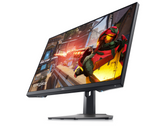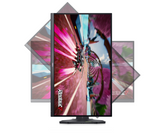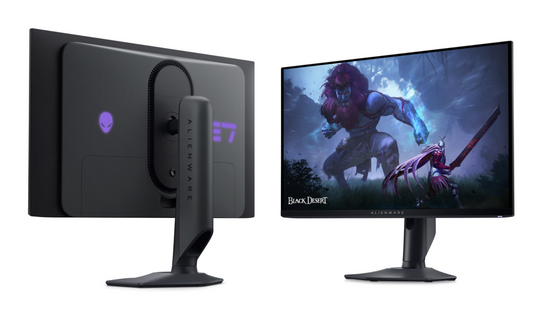-
Dell Graded AW2725DF - 3 YR Dell Warranty
Regular price £425.00 GBPRegular priceUnit price / per£729.00 GBPSale price £425.00 GBPSale
Collection: Gaming Monitors
Understanding Gaming Monitors



What are gaming monitors?
The primary distinction between a gaming monitor and a standard monitor lies in the picture quality and performance it offers. Gaming monitors are equipped with features such as variable refresh rates and Adaptive-Sync technology, allowing for smoother visuals and a lag-free gaming experience. With quicker response times, pixels can change colour faster, enhancing the images on screen for a more vibrant display. Curved designs are popular for gaming monitors, providing an increased peripheral view and creating a more immersive gaming experience. Additionally, gaming monitors come in attractive designs with different colour options and ambient lighting such as the AlienFX Lighting system. They also offer convenient features like cable management systems, adjustable stands, and additional ports for accessories like speakers, headphones, and keyboards. Ultimately, gaming monitors are designed to optimise the gaming experience, with hardware specifically tailored for your gaming PC or console, you can enjoy your favourite games with the highest levels of performance and picture quality.
A Few Key Features to Look For
Refresh rate
Playing games on a higher refresh rate monitor can greatly enhance your gaming experience. The higher the refresh rate, the smoother and more realistic the motion on the display appears. This is particularly true in fast-paced and competitive games where every frame counts. However, simply buying a 144Hz monitor, or even a 500Hz monitor, is not enough. Your gaming setup must be able to power the frame rate necessary to take advantage of a higher refresh rate. The refresh rate of a display is measured in Hertz (Hz), indicating how many times per second the screen can draw a new image. To fully utilise higher refresh rates, you need a fast monitor, a CPU that efficiently processes game instructions, and a GPU that can quickly execute them. By ensuring all these components are top-notch, you can enjoy smoother gameplay and improved overall gaming performance.
Resolution
Monitor resolution refers to the clarity with which a monitor can display visual content. The term refers to the number of pixels that make up the monitor's display, with higher resolution monitors having more pixels. For example, a monitor with a 4K resolution (3840 x 2160p) has a higher pixel count than one with QHD (2560 x 1440p) or FHD resolution (1920 x 1080p) . The native resolution of a monitor is the resolution at which it performs best, as this is the resolution that matches the physical grid of pixels on the screen. A higher resolution monitor allows for more detailed images and more content to be displayed on the screen at once, providing a clearer and more immersive viewing experience.
Adaptive Sync Technology
Manufacturers such as NVIDIA, AMD, and VESA have developed various display technologies. One of these key technologies is Adaptive Sync. This helps to synchronise frame rates and refresh rates in order to prevent screen tearing & stuttering. In gaming, different scenes require different frame rates depending on the level of graphics and effects present. High frame rates are essential for smooth gameplay and technologies such as AMD FreeSync monitors or Nvidia G-Sync monitors will work with your graphics card to optimise refresh rates for a seamless experience; for example an Nvidia geforce GPU will perform better with an Nvida GSync monitor. By ensuring that the frames rendered by the graphics processor match the refresh rate of the monitor, players can enjoy improved speed and graphics without any noticeable difference in performance. This synchronisation of frame and refresh rates is crucial for enhancing the overall gaming experience and eliminating any potential disruptions in gameplay.
Response time
Response time refers to the amount of time it takes for the pixels on a monitor to change colour, with most monitors having a response time ranging from 1 to 30 milliseconds. Monitors with a response time within this millisecond range are ideal for everyday activities such as work tasks, virtual meetings, image editing, and video streaming. When considering what constitutes a good response time for a gaming monitor, it is essential for gamers to seek out a display with a low response time of one to five milliseconds. This is crucial to ensure that there is minimal delay between the monitor receiving input from the graphics card and displaying it on the screen. A faster response time can result in smoother gameplay, reduced motion blur, and overall improved performance. It is also important to consider other factors such as refresh rate, resolution, and panel type to fully optimise the gaming experience. Therefore, when selecting a gaming monitor, prioritising a low response time is key to achieving optimal performance and responsiveness in gameplay.
Connectivity options
Most gaming monitors typically come equipped with a variety of ports to cater to all your gaming accessory needs. In addition to the standard HDMI and DisplayPort connections, you may also find USB ports and audio jacks available. These ports not only allow you to easily connect your peripherals like keyboards and mice, but also give you the option to attach dual monitors, external sound systems, and other devices to enhance your gaming setup. The flexibility provided by these ports ensures that you can customise your gaming experience to suit your preferences and needs.


